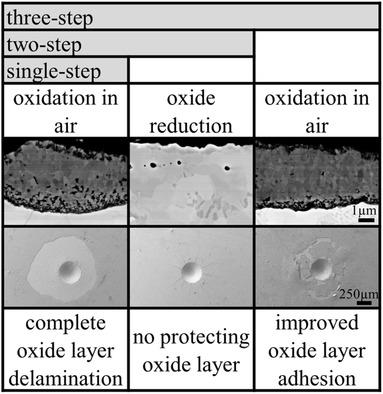当前位置:
X-MOL 学术
›
Adv. Eng. Mater.
›
论文详情
Our official English website, www.x-mol.net, welcomes your
feedback! (Note: you will need to create a separate account there.)
Improving the Adhesion of a Hard Oxide Layer on Ti6Al4V by a Three-Step Thermal Oxidation Process
Advanced Engineering Materials ( IF 3.4 ) Pub Date : 2021-09-02 , DOI: 10.1002/adem.202100864 Daniel Dickes 1 , Beyza Öztürk 2 , Rainer Völkl 1 , Mathias C. Galetz 2 , Uwe Glatzel 1
Advanced Engineering Materials ( IF 3.4 ) Pub Date : 2021-09-02 , DOI: 10.1002/adem.202100864 Daniel Dickes 1 , Beyza Öztürk 2 , Rainer Völkl 1 , Mathias C. Galetz 2 , Uwe Glatzel 1
Affiliation

|
Thermal oxidation is a promising technique to improve the tribological properties of Ti6Al4V. Herein, a single-step process consisting of oxidation in air, a two-step process with an additional solid-state oxide layer reduction step under vacuum, and a three-step process with an appended final oxidation step in air are applied to Ti6Al4V. The oxide layer adhesion after the three-step process is improved compared with the single-step process. This improved adhesion is not due to a different nature of the oxide layers because oxide layers obtained during the single-step and three-step process show a similar morphology and composition. Instead, it is ascribed to the presence of an optimized oxygen diffusion zone with two distinct regions: a gradual decrease in oxygen concentration from the maximum possible oxygen concentration at the oxide–substrate interface until a depth of 20 μm followed by a near-linear decrease until a depth of about 85 μm. Both regions are also visible in the correlated microhardness-depth profile.
中文翻译:

通过三步热氧化工艺提高 Ti6Al4V 上硬质氧化物层的附着力
热氧化是改善 Ti6Al4V 摩擦学性能的一种很有前景的技术。在此,由空气中氧化组成的单步工艺、在真空下附加固态氧化层还原步骤的两步工艺和在空气中附加最终氧化步骤的三步工艺适用于 Ti6Al4V。与单步工艺相比,三步工艺后的氧化层附着力有所提高。这种改进的粘附性不是由于氧化物层的不同性质,因为在单步和三步工艺中获得的氧化物层显示出相似的形态和组成。相反,这归因于存在具有两个不同区域的优化氧扩散区:氧浓度从氧化物-基材界面处的最大可能氧浓度逐渐降低,直到 20 μm 的深度,然后近似线性降低,直到约 85 μm 的深度。这两个区域在相关的显微硬度深度剖面中也可见。
更新日期:2021-09-02
中文翻译:

通过三步热氧化工艺提高 Ti6Al4V 上硬质氧化物层的附着力
热氧化是改善 Ti6Al4V 摩擦学性能的一种很有前景的技术。在此,由空气中氧化组成的单步工艺、在真空下附加固态氧化层还原步骤的两步工艺和在空气中附加最终氧化步骤的三步工艺适用于 Ti6Al4V。与单步工艺相比,三步工艺后的氧化层附着力有所提高。这种改进的粘附性不是由于氧化物层的不同性质,因为在单步和三步工艺中获得的氧化物层显示出相似的形态和组成。相反,这归因于存在具有两个不同区域的优化氧扩散区:氧浓度从氧化物-基材界面处的最大可能氧浓度逐渐降低,直到 20 μm 的深度,然后近似线性降低,直到约 85 μm 的深度。这两个区域在相关的显微硬度深度剖面中也可见。











































 京公网安备 11010802027423号
京公网安备 11010802027423号